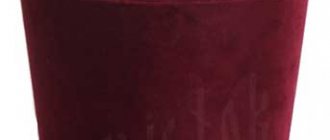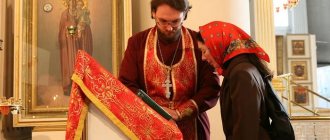Cassock - (often) the lower (but not in all cases), length to the toes, vestment of clerics and monks with narrow (unlike the cassock) sleeves. By the name itself, the purpose of the cassock in a utilitarian sense is clear - it is worn under the cassock. Meanwhile, the cassock, as part of a special vestment, also has a more sublime meaning.
The emergence of the cassock is directly related to the emergence of the tradition of wearing a cassock (from the Greek ράσον, “clothing made of smooth fabric, without lint,” “monastic vestments”). There is an assumption that the shape of the cassock was borrowed from the pallium - the outer cloak that was traditionally worn by the philosophers of Antiquity. The pallium was very popular primarily among monasticism and partly among the priesthood (in particular, Blessed Jerome wore a pallium). Under the pallium it was always customary to wear some kind of lower clothing, usually a chiton or exomis, which became the prototype of the cassock both in purpose (underwear under the cloak) and in cut (underwear with narrow sleeves, usually down to the toes). Only representatives of the Cynic philosophical school did not, in principle, wear lower clothing under the pallium. Although it should be admitted that many researchers find parallels between the clothes of the New Testament clergy with the clothes of the Old Testament Levites and priests. It should be noted that the Roman Church tried to fight the fashion for the clothes of philosophers among the priesthood and episcopate. So Pope Celestine in the 5th century prohibits its wearing. However, already in the 6th century, the population of the territories of the former Roman Empire almost completely abandoned wearing long robes up to the toes, which was associated with the “barbarization” of the style of clothing and the death of the Greco-Roman civilization. The clergy, on the contrary, strives to preserve the Roman style of dress with minor changes and differs from the laity. In particular, the Council of Agde in 506 obliges clergy to wear the clothes and shoes that they wore before - that is, the likeness of ancient palliums and tunics (i.e. cassocks). Bishop Martin of Prague (the patron saint of this city) in 572 ordered the clergy to wear clothes up to the toes. In the Orthodox East, the wearing of upper and lower clothing to the toes was consolidated in the 7th century, since the 27th rule of the Trullo Council determines for the clergy the wearing of the clothes that the clergy wore earlier in order to separate the clergy from the laity (“None of those listed in the clergy should dress in indecent clothing, neither while in the city nor on the road, but each of them wears clothes already prescribed for those in the clergy." In the 10th century in the Orthodox East, the color of the clergy’s clothing—the cassock and cassock—finally became black, with rare exceptions.
In Rus', the Greek cassock for a long time, until the 17th century, was replaced by a single-row caftan, which could be both lower and outer clothing (at the moment, the cassock plays the same role - it can be worn both under a cassock and as an outer garment clothes over a shirt and T-shirt). After the appearance of Greek examples of church clothing in Rus', the caftan ceased to be used and many Russian regional cassock cuts appeared.
Types of cut of Orthodox cassocks
There are many types of cassock, depending on the cut of the chest and collar. A special feature of the cassock cut is the seam of the sleeves from the back, unlike ordinary shirts or jackets, with a seam across the shoulder. This is due to the functional purpose of the cassock not only as the priest’s everyday clothing, but also as liturgical clothing. This cut of the sleeves allows the priest to move more freely during the service, in particular, during the raising of his hands or the offering of the Holy Gifts. Regular or tight buttons made of a variety of materials, metal or plastic hooks, knots, and even rivet buttons are used as fasteners for cassocks. The cassock skirt is usually flared down at the sides. The cassock may have pockets (two or one on the chest, two deep pockets on the sides in the seams), or not. Cassocks are made in many types of fabrics, but the most popular are blends of polyester, linen, cotton and in some cases silk and viscose.
The most popular in Russia and available in the assortment of modern stores and vestment manufacturers are:
- Russian cassock - cut to the bottom, with a wrap to the right or left, the presence of an internal button on the belt. Not fitted; a soutache, woven or other belt is needed to secure the waist. The Russian cassock is complemented by a Russian collar (the collar is fastened with an overlap or a butt button, like a kosovorotka shirt) or a Greek collar (a stand-up collar and a hook-shaped clasp in the middle). A variety of the Russian cassock is the “Arkhangelsk”, “northern” or “Pomeranian” cut, which is partly preserved by the Old Believers. It has a slit to the waist and, as a rule, a butt or overlapping collar, essentially representing a shirt-shirt on top with a skirt at the bottom (in some cases, the cut of the sleeves does not come from the back, but from the shoulder).
- Greek cassock - cut to the bottom, with a wrap to the right or left, the presence of an internal button on the belt. It may or may not be fitted. It has a soutache or fabric belt sewn at the lumbar level to secure it at the waist. A stand-up collar with a hook-type clasp in the middle.
- Bulgarian cassock - can have a cut both to the bottom and to the waist. Instead of a wrap, a classic shirt cut is used on the chest (like a medieval single-row shirt). Stand-up collar with hooks or buttons. Like the Russian cassock, the Bulgarian one does not have a belt sewn in at the waist level.
How to sew a Greek cassock. Cassock pocket
Processing a pocket on a Greek cassock. Text with detailed photo at the link. https://www.nazaretriza.com/blog
The Greek cassock has two most characteristic and recognizable differences. This is the pocket of the Greek cassock and the side slit at the bottom of the Greek cassock. The remaining elements: upper patch pockets, belt, drawstring for the belt - can be used in other products.
You could even say that the pocket and classic side slit are the hallmark of the Greek cassock. For example, the smell of the Russian cassock has, at first glance, much in common with the Greek version. However, the pocket in Russian cassocks is completely different from the Greek style. It is unique in its design. However, not everyone likes it due to its functionality. It happens that, at the request of the customer, I put a Russian version of the pocket in the Greek cassock.
But in this post I want to talk about the technology for assembling a Greek pocket.
There are several options for assembling such a pocket. I want to tell you how I do this on products from Our workshop.
Let's get started:
On the side parts of the cassock (the wedges of the front and back), along the side cut, move 6 cm -7 cm from the top (in some examples they write to step back from the edge 4 cm, but I set aside 6 cm. In my opinion, when such a pocket is located just below the hip line, then it does not puff up on the sides and looks better in the product). Place a mark. Set aside 18cm from the mark and place a second mark. This will be the entrance to the pocket.
1st option. Simplified.
Duplicate the entrance to the pocket from the inside with non-woven fabric or dublerin (this is better) with an allowance for stitching. The duplicating material should protrude beyond the pocket entrance marks by about 1-2 cm. Depends on the allowance left for the seams. Connect the side parts along the marks and sew a stitch with fastenings, leaving the entrance to the pocket free. Press seams. Place a finishing stitch along the entrance of the pocket to the width of the allowances. Choose any form you wish. Rectangular, rounded and sharp at the ends, figured embroidery-stitching.
2nd option.
Prepare facing for pocket opening. Two-piece facing with seam allowances. The shape of the facing is optional. The width of the facing is no more than 3cm. The facing details are duplicated with adhesive material. Place marks to enter the pocket. Overlock the outer edges. Apply facings to the sides of the front and back where the pocket is marked. Connect each one separately with pins along the marks. Sew only along the 18cm pocket entry line! Connect the main side parts of the shelf and back, aligning and pinning the entry points into the pocket. Stitch the side seams for the left and right halves, leaving the entrance to the pocket free. The connecting lines of the pocket and side cut stitches must coincide exactly at the marking points! Also stitch the remaining edges of the facing. Trim off half the facing allowance at the pocket entrance. This will soften the entrance to the pocket and eliminate unnecessary stiffness of the seams. On the wrong side, stitch the entrance to the pocket with a piping. Iron the result.
Continuing work for the 2nd option, prepare the burlap pockets. Two parts from the main material and 2 parts from the lining. I cut the burlap pockets deep, the width of the entire barrel part (front and back) to the waist line. Place marks on the burlap pocket lining material for entry into the pocket. Since the burlap is one-piece cut (for the strength of the pocket), you need to cut out the entrance to the pocket on it without seam allowances. Place the part on the wrong side under the facing. Secure with pins and stitch along the front side in any shape. I have a sample with corners at the ends.
Place a burlap pocket made of the main material on the top, from the wrong side. Align along the cuts and secure with pins. Place a securing stitch along the very edge around the entire perimeter. On the front side, additionally stitch the bottom of the pocket (in the finished form, two finishing stitches at the bottom of the pocket. Iron. The pocket is ready.
Text with detailed photo at the link.
https://www.nazaretriza.com/blog
Everyday vestments of a clergyman, cassock and cassock
The robes of clergy are visual evidence of their rank and title. They do not look like the clothes of an ordinary person, and thereby distinguish a clergyman from among the laity - even the most unchurched people can easily distinguish the priest’s attire from the ordinary everyday clothes of a modern person. This has its own meaning and history, it emphasizes that the Church is beyond the worldly, the momentary, beyond the flow of time and the demands of fashion, and for the clergy it is a constant reminder of the highest service entrusted to them by God.
The well-being and comfort of clergy largely depends on the quality and convenience of church vestments. Despite all the traditional nature of church vestments, it is impossible to completely isolate yourself from the new realities of sewing production. What requirements does church discipline impose on the appearance of a priest today? How are they implemented using modern technologies?
In this article we will focus on the everyday attire of clergy - the cassock and cassock.
The general symbolic meaning of the cassock and cassock is an internal renunciation of worldly worries and vanity, peace and tranquility of the heart, a sign of spiritual peace. The cassock and cassock are an image of the outer clothing that the Lord Jesus Christ wore during his earthly life. Thus, by wearing them, representatives of the clergy and monasticism imitate Jesus Christ according to the commandment that he gave to His disciples.
Cassock
- This is the lower robe of a clergyman. Its color indicates which clergy - black (monastic) or white (parish priesthood) the one who wears it belongs to. The requirements for monastic priests are more stringent - their cassock can only be black. White clergy are given a relaxation in this regard, and in addition to black, they can choose dark blue, brown, gray and white attire. In modern sewing production, melange fabrics are also used for cassocks - a combination of fibers of different shades (for example, blue and white threads), which under different lighting highlights one or another tone.
The materials for making cassocks are usually cloth, wool, satin, flax, comb, and silk. Modern technologies can offer clergymen so-called “wet” silk for sewing cassocks - products made from such fabric are very soft and pleasant to the touch, resistant to wrinkles and at the same time retain the flowing texture of silk. Summer cassocks in our time are most often sewn from cotton and linen in a ratio of 80 to 20, 50 to 50, or from pure flax. In winter, wool and synthetics are quoted.
Cassocks can be decorated with embroidery along the collar or along the sides. At the same time, for the ornament, threads are taken to match the cassock, which gives it discreet beauty, or contrasting colors, which makes the cassock brighter and more elegant.
Cassock
(Greek “to roson” - torn, worn out, lint-free clothing) - the outer robe of monks and clergy of all degrees with long, below the palms, wide sleeves, mostly black (for monastics). For white clergy, in addition to black, dark blue, gray, brown, cream and white are possible. As a rule, the cassock is fastened at the collar and at the belt.
The materials for cassocks are the same as for cassocks, moreover, both of them can be lined.
All services, except the Liturgy, must be performed by the priest in a cassock and cassock. In addition, at different moments of different services, other liturgical vestments (robes) are worn over them, the use of each of which is determined by the Charter. When serving the Liturgy and in other cases when the priest must be in full liturgical vestments, the cassock is removed and the so-called cassock and other vestments are put on over the cassock.
Features of the cut.
Nowadays in Russia, priests wear two main styles of cassocks and cassocks: Russian and Greek. This is allowed by the church charter, but for some official events the clergy is obliged to appear in robes of Russian cut. Church discipline requires that the robes be long enough and extend to the edge of the shoes. Shoes must be black, without patterns, closed.
Russian cut
The Russian cassock and cassock come from the single-row caftan worn by our ancestors. By the way, until the 17th century, the clergy wore just such caftans, and not cassocks, but the formation of the Russian cassock occurred under the influence of the penetration of Greek robes for the clergy into our country. The caftans that the priests wore could be made from cloth of different colors: crimson, purple, green. They had narrow sleeves - in contrast to the Russian cassock that emerged later. By the way, it is known that the love of the Russian clergy for clothes of bright colors continued until the revolution itself; for example, crimson clothes were worn well.
The Russian cassock and cassock are fastened “with a wrap” (in the manner of a Russian kosovorotka) and have a fitted style. There are two variations of the Russian cassock: Kiev - fitted only on the sides and leaving the back straight, and Russian - fitted on all sides.
The sleeves of the cassock are narrow, while the sleeves of the cassock are narrow at the shoulders and greatly widen at the bottom.
Russian cut suits the harsh climate of our country: it allows you to save heat.
Greek cut
The Greek cassock and cassock came to Rus' in the 17th century, when the Great Moscow Council of 1666-1667 allowed the clergy to wear them. Both the cassock and the cassock have a stand-up collar. They are much wider than Russian ones, not fitted. The cassock has a drawstring on the back that allows you to adjust the width, and there are pockets on the chest.
The cassock is fastened only at the collar and chest. In fact, such a cassock is a transformation of an oriental robe. The sleeves of the Greek cassock are wide along the entire length. This meets the requirements of the hot southern climate, where this type of clothing was formed - Greek robes made of natural silk are especially good in this regard. Russian priests gladly wear such robes in the summer; many clergy prefer them at any time of the year, valuing freedom of movement. Such robes are also convenient for those priests whose weight constantly fluctuates.
In Greece, priests wear black cassocks and cassocks; the Russian tradition of colored robes for the clergy causes them some surprise. Cassocks with satin silk cuffs on the sleeves are common. But these lapels can also be colored - for example, purple.
Bulgarian cassock.
The cassock, called Bulgarian, is a kind of hybrid of Russian and Greek cut. It has a “Greek” stand-up collar and overlapping hems, like a Russian cassock.
The choice of attire is a matter of taste and personal convenience of the clergy. The variety of modern fabrics, as well as the various advantages of a particular style, allow you to choose the option that is most comfortable for everyone.
Here is the opinion of one of our Russian priests: “I like the Russian cassock, there is something familiar in it. And Greek is a good way out in the summer heat. Some seamstresses make the mistake of not taking into account the difference between male and female figures, and the waist of the Russian cassock they sew ends up in the armpit area. Of course, this is wrong: the cassock is not a woman’s dress, and its waist should be in its place. They often sell cassocks and cassocks with unhemmed bottoms - meaning that everyone will tailor them to their height. But if necessary, you can shorten the hemmed vestment. Still, it’s more pleasant to buy clothes that you can wear right away.”
The trading and manufacturing enterprise ORTOX offers cassocks of Russian and Greek cut made of linen, cotton, gabardine, wet silk, melange, viscose, wool blend, cashmere. Colors and embroidery are available in assortment.
Products are made to order within a week. To place an order, your measurements and height are required. The bottom can be hemmed or left unhemmed according to your wishes.
You can place an order on the website or in our groups on social networks https://vk.com/ortox, https://www.facebook.com/ortox.ru/, https://www.instagram.com/ortoxru/
For clarification of questions, please contact the contacts listed on the website.








